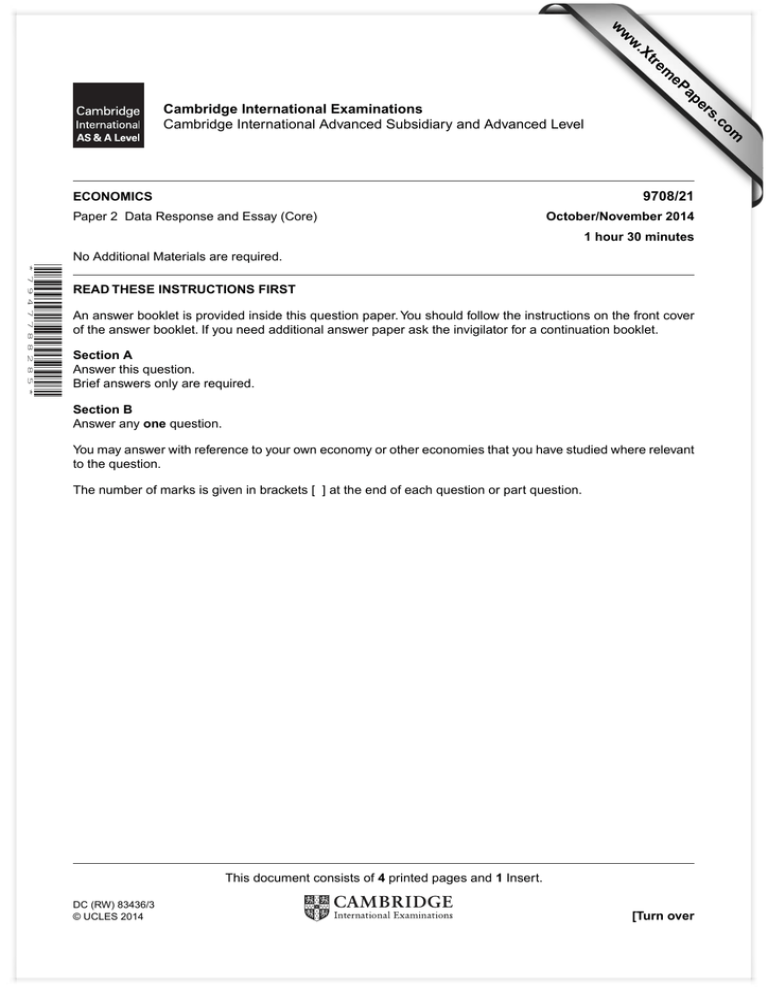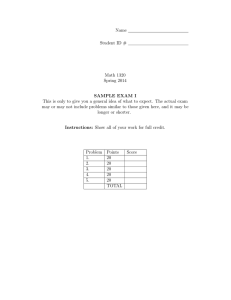
w
w
ap
eP
m
e
tr
.X
w
om
.c
s
er
Cambridge International Examinations
Cambridge International Advanced Subsidiary and Advanced Level
9708/21
ECONOMICS
Paper 2 Data Response and Essay (Core)
October/November 2014
1 hour 30 minutes
No Additional Materials are required.
* 7 9 4 7 7 8 8 2 8 5 *
READ THESE INSTRUCTIONS FIRST
An answer booklet is provided inside this question paper. You should follow the instructions on the front cover
of the answer booklet. If you need additional answer paper ask the invigilator for a continuation booklet.
Section A
Answer this question.
Brief answers only are required.
Section B
Answer any one question.
You may answer with reference to your own economy or other economies that you have studied where relevant
to the question.
The number of marks is given in brackets [ ] at the end of each question or part question.
This document consists of 4 printed pages and 1 Insert.
DC (RW) 83436/3
© UCLES 2014
[Turn over
2
Section A
Answer this question.
1
The world coffee market
Extract 1: Colombia losing ground in coffee market
Until the 1980s, Colombia was the second largest coffee producer in the world. Coffee cultivation
contributed to a growth in incomes, a positive trade balance and employment. But at the end of the
1980s things started to change for the worse. Between 1989 and 2011, the country lost 7% of its share
in the world coffee market, while Brazilian coffee producers increased exports. New producers entered
the market and Colombia fell to fourth in the world in terms of the production of coffee.
Increased international competition is not the only reason that Colombian coffee producers are
suffering. The harvest in 2011 was the smallest in 30 years, mostly due to heavy rains in the main
coffee-producing regions. In addition, there are problems related to climate change, which cause
increased coffee crop diseases that result in increased costs.
Source: All rights reserved © Worldcrunch – in partnership with AMERICA ECONOMIA
Extract 2: Nepalese farmers gain from global thirst for coffee
Nepal’s hills are suitable for coffee growing and more farmers are turning to the crop, attracted by
the high export prices. There is rapidly rising demand for coffee, especially in traditional tea-drinking
countries such as China and India. Coffee growing in Nepal is booming. Total annual production is
more than 30 times the crop in the early 1990s. Every year, 16% more land is being used for coffee and
production is increasing by 20%. The industry now employs more than 25 000 people.
Coffee is one of the few industries in Nepal, other than tourism, that is thriving. Farmers are attracted to
coffee as it is more profitable to grow than traditional crops such as maize and millet.
Most Nepalese coffee is exported. Coffee consumption is forecast to increase globally by about 3% per
annum over the next decade, as it did over the past decade. Rising incomes, combined with advertising,
is likely to encourage coffee drinking in countries such as China and India where coffee is not part of
traditional culture.
Coffee exports are generating much-needed foreign reserves for the Nepalese government, and
income for agricultural communities. In Nepal, too, demand is growing fast.
Source: The Guardian, newspaper 2012
© UCLES 2014
9708/21/O/N/14
3
Table 1: The annual average price of coffee
(US cents per unit)
Year
Price
2007
107.68
2008
124.25
2009
115.67
2010
147.24
2011
210.39
2012
156.34
Source: International Coffee Organisation
(a) Describe the overall trend in coffee prices between 2007 and 2012 and identify one year in
which supply was likely to have exceeded demand in the market for coffee.
[2]
(b) Explain how coffee exports and a thriving tourism sector would contribute to Nepal’s current
account in the balance of payments.
[4]
(c) With reference to Extract 2, explain how you would classify coffee using the concept of income
elasticity of demand.
[2]
(d) Using diagrams, explain how changes in demand and supply have affected the coffee market
in Colombia and in Nepal.
[6]
(e) Discuss the view that Nepal should specialise in the production of coffee and Colombia should
specialise in some other product given the changes in costs that have occurred.
[6]
© UCLES 2014
9708/21/O/N/14
[Turn over
4
Section B
Answer one question.
2
(a) Using a supply and demand diagram, explain how the imposition of a subsidy on a good
would affect the surplus enjoyed by the producers of that good.
[8]
(b) Discuss whether minimum price legislation or the imposition of an indirect tax is more
effective in improving resource allocation when the consumption of a good causes negative
externalities.
[12]
3
(a) Explain the factors that determine whether the price elasticity of demand for a product has a
high value or a low value.
[8]
(b) Discuss whether it is both possible and beneficial for a business to change the price elasticity
of demand for its product.
[12]
4
(a) Explain how tariffs and an undervalued exchange rate can operate to protect a domestic
market from foreign competition.
[8]
(b) Discuss whether protectionism disadvantages most people in the protected country.
[12]
Copyright Acknowledgements:
Question 1
Question 1 Table
© Tamara Munoz; Columbia Losing Edge in Coffee Market; http://www.worldcrunch.com; 9 September 2012.
© Ishwar Rauniyar & Jason Burke; Nepalese farmers tap into global thirst for coffee; Guardian News & Media Ltd;
18 December 2012.
© Coffee Annual Average Price (US cents/lb); International Coffee Organisation; http://www.ico.org; 6 January 2013.
Permission to reproduce items where third-party owned material protected by copyright is included has been sought and cleared where possible. Every
reasonable effort has been made by the publisher (UCLES) to trace copyright holders, but if any items requiring clearance have unwittingly been included, the
publisher will be pleased to make amends at the earliest possible opportunity.
Cambridge International Examinations is part of the Cambridge Assessment Group. Cambridge Assessment is the brand name of University of Cambridge Local
Examinations Syndicate (UCLES), which is itself a department of the University of Cambridge.
© UCLES 2014
9708/21/O/N/14


![저기요[jeo-gi-yo] - WordPress.com](http://s2.studylib.net/store/data/005572742_1-676dcc06fe6d6aaa8f3ba5da35df9fe7-300x300.png)